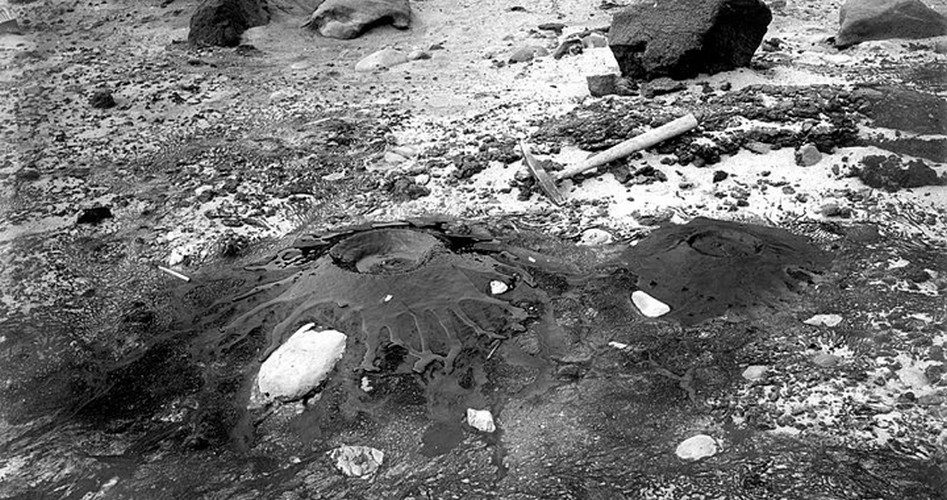
A federal agency reported Tuesday that its previous estimate of the amount of recoverable oil from California deposits was way too optimistic. Its 2012 estimate that the Monterey formation contained 13.7 billion barrels of recoverable oil was cut to 600 million barrels, just four percent of its previous estimate. Adam Sieminski, head of the Energy Information Administration (EIA), said:
The EIA concluded that the technical recoverability of Monterey shale did not look as strong in 2014 because of the industry’s difficulty in producing from the region….
Not all resources are equal. It turns out that it is harder to crack the reservoirs and get the oil flowing from the Monterey [than from the Bakken or Eagle Ford formations].
The rocks are still there. The technology is not there yet.
The lead analyst for EIA, John Staub, explained why there was such a sharp and surprising downgrade on reserves that many in California were hoping would spark a boom in both new jobs and new revenues for the state:
From the information we’ve been able to gather [from oil producers in the region], we’ve not seen evidence that oil extraction in this area is very productive….
Our oil production estimates combined with a [lack] of knowledge about geological differences among the oil fields led to [our previous] erroneous predictions and estimates.
Previous estimates were that development of the Monterey formation, which stretches 1,750 miles underground from Sacramento to Los Angeles, could generate 2.8 million new jobs and boost state revenues by $24.6 billion a year. With the new numbers, job gains might be closer to 100,000 and new revenues at less than $1 billion.
The Monterey formation has been described as “folded,” “jumbled,” and “shattered” instead of neatly piled up like a stack of pancakes as in North Dakota’s Bakken or the Eagle Ford formations in Texas, making it more difficult and costly for oil companies to extract the oil deposits. At the moment, according to Staub, production from the Monterey formation is “stagnant.”
The surprising downgrade has predictably delighted environmentalists, who would rather have the oil remain in the ground. Seth Shonkoff, executive director of the left-wing Physicians Scientists & Engineers for Healthy Energy, chortled: “The narrative of fracking in the Monterey Shale as necessary for energy independence just had a big hole blown in it.” And David Hughes, a spokesman for the anti-carbon group Post Carbon Institute, insisted that the Monterey formation “was always [a] mythical mother lode puffed up by the oil industry. It never existed.” He added, “The oil had always been a statistical fantasy. Left out of all the hoopla was the fact that the EIA’s estimate was little more than a back-of-the-envelope calculation.”
The Wall Street Journal gave significant air time to another hard-core environmentalist, Christopher Martenson, allowing him to vent his glee over the downgrade. Martenson has an opinion that “peak oil” is inevitable, but he lacks any credible training or education in the energy exploration business. Instead he sports a Ph.D. in neurotoxicology and an MBA. As a fellow of the Post Carbon Institute, however, he asserts that the recovery of petroleum resources from places such as Monterey will eventually decline over time: “The big story is this: the world has physical limits that we are already encountering, but our economy operates as if no physical limits exist.”
His Malthusian peak-oil worldview permeated his remarks on Thursday, published by the Journal’s MarketWatch blog:
The reasons for the downgrade are easy enough to understand. The initial estimates were mere guesses that relied on company statements and not actual results. Now, with enough wells in play, the Energy Information Agency [sic] can calculate the potential of the Monterey play and it’s obviously a lot less than [was] originally thought.
With that, California’s dreams of 2.8 million new jobs from the Monterey shrank to 112,000 and the hoped-for $24.6 billion in [new] tax revenues withered to $984 million.
More importantly, the U.S. shale “miracle” turned into a pumpkin overnight with overall U.S. reserves shrinking from approximately 24 billion barrels to approximately 11 billion barrels.
Tuesday’s downgrade by the EIA makes the dream of energy independence much less realistic, according to Martenson, and could lead to “increasing geopolitical unrest” as “energy prices continue their march upwards.”
In the real world, where real engineers and energy development experts live, however, the word “recoverable” is operative. At the moment the vast Monterey reserves are not recoverable using today’s technology. Prior to 2005 neither were the reserves at Eagle Ford or Bakken or Barnett or Marcellus (in Pennsylvania). But along came George Mitchell who, with grit and determination, developed the fracking protocol that has turned those fallow resources into economic miracles.
Amy Myers Jaffe, the executive director of energy at UC Davis, is spot on:
The academic geologists [like Martenson, Shonkoff, and Hughes] said the same thing about the Barnett Shale.… They said it wasn’t recoverable and it wasn’t going to produce.
That didn’t turn out to be right.
Some of those companies are not going to give up [on Monterey]. The first companies that went into North Dakota had problems too. It’s very early to be making a definitive judgment.
As Mark Twain famously said, “The reports of my death have been greatly exaggerated.” So too is the death knell for Monterey or for fracking itself.
Photo of oil welling up from the Monterey formation
A graduate of Cornell University and a former investment advisor, Bob is a regular contributor to The New American magazine and blogs frequently at www.LightFromTheRight.com, primarily on economics and politics. He can be reached at [email protected].



